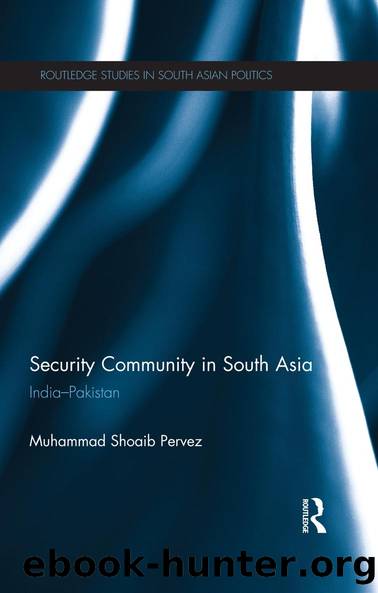Security Community in South Asia by Muhammad Shoaib Pervez

Author:Muhammad Shoaib Pervez [Pervez, Muhammad Shoaib]
Language: eng
Format: epub
Tags: History, Asia, India & South Asia
ISBN: 9780415531504
Google: ha5-6udOXeAC
Publisher: Routledge
Published: 2013-01-15T15:54:50+00:00
'Kashmiriyat': the essence of an indigenous identity of Kashmir
This section will explore the identity of Kashmir independent of the parameters designed by Indian and Pakistani elites. The Kashmir problem emerged due to the convergence of three factors. Varshney identifies these as: âreligious nationalism represented by Pakistan, secular nationalism epitomized by India, and ethnic nationalism embodied in what Kashmiris call Kashmiriyatâ (Varshney 1991: 999). Kashmir has a specific culture and identity of its own. The history of Kashmir from medieval times until the present is important for uncovering certain peculiar socio-cultural norms broadly subsumed under the rubric of âKashmiriyatâ. Kashmir was dominated by four centuries of âimperial rule, from Mughal (1586 1757) and Afghan (1757â1819) to Sikh (1819â1846) and Dogra (1846â1947)â (Cockell 2000: 326). Therefore, the desire for self-rule has always been the core âvaluationalâ determinant for the identity of Kashmir (Cockell 2000). âThe essence of Kashmiriyat ethnicity is the network of socio-cultural, historical and linguistic ties that bound all Kashmiris, regardless of religion, into an interdependent social collectiveâ (Cockell 2000: 327).
During the rule of the Dogra Raj, the Kashmir valley remained geographically isolated from the rest of the subcontinent. This helps to explain why the Kashmiri identity is different from the identity of the Muslims and the Hindus of the subcontinent. While in the subcontinent religious differences and divergent cultures led to a communal divide, in Kashmir, religious diversity has created a common collective identity. As I will explain below, this identity complex has four distinct components which include religious tolerance, desire for freedom, socio-cultural distinctiveness and linguistic similarity.
The religious norms include ârishiâ which focused on the development of âmutual tolerance and non-orthodox devotionâ especially among co-religionists, the Hindus and the Muslims (Cockell 2000: 327). It is ironic that in contrast to other regions in India, the spread of Islam was peacefully introduced to the Kashmir by mystics and Sufis referred to as âRishisâ (Khan 1994). Muslim rule in Kashmir was established without any bloodshed. Islam was propagated peacefully through the efforts of Mir Sayyid Ali and his followers in the medieval period (Bazaz 2003). The reason behind this is that Sufism in Islam and Shaivism âTrikaâ of the Hindus in Kashmir were akin to each other (Bazaz 2003). Both focused on respect for co-religionists and they believed in âreligious Humanismâ (Khan 1994). In Kashmir, the saints of Islam are revered by both Hindus and Muslims alike, e.g., Lalla, Lal Ded, Sheikh Norruddin, called âShazanandâ by the Hindus (Bazaz 2003). After the death of Sheikh Norruddin in 1808 AC, his followers formed a religious order called the âRishis or Babasâ in Kashmir (Bazaz 2003). It is based on âReligious Humanism under the veneer of Islamâ (Bazaz 2003: 87). Although the basic tenants of the Quran remain the same, there was a peculiar synthesis of Islamic traditions with the regional socio-cultural norms of Kashmir (Bazaz 2003).
The spread of Islam in Kashmir during the thirteenth and fourteenth centuries was neither abrupt nor violent, but rather it subtly altered âthe social structure of the Kashmirisâ(Iqbal and Nirash 1978: 15).
Download
This site does not store any files on its server. We only index and link to content provided by other sites. Please contact the content providers to delete copyright contents if any and email us, we'll remove relevant links or contents immediately.
The European History Highway: A Guide to Internet Resources by Dennis A. Trinkle Scott A. Merriman(494)
The Seven Wonders of the Ancient World by Michael Denis Higgins(477)
European Security in a Global Context by Thierry Tardy(470)
European Security without the Soviet Union by Stuart Croft Phil Williams(469)
The Routledge companion to Christian ethics by D. Stephen Long Rebekah L. Miles(458)
Hudud Al-'Alam 'The Regions of the World' - a Persian Geography 372 A.H. (982 AD) by V. V. Minorsky & C. E. Bosworth(399)
Gorbachev And His Generals by William C. Green(391)
Get Real with Storytime by Julie Dietzel-Glair & Marianne Crandall Follis(390)
Tibetan Studies in Comparative Perspective by Chih-yu Shih Yu-Wen Chen(385)
Governance, Growth and Global Leadership by Espen Moe(381)
Hyperculture by Byung-Chul Han(378)
CliffsNotes on Fitzgerald's The Great Gatsby by Kate Maurer(360)
The Oxford History of the World by Fernández-Armesto Felipe;(354)
How Languages Are Learned 5th Edition by Patsy M Lightbown;Nina Spada; & Nina Spada(353)
The Egyptian Economy, 1952-2000 by Khalid Ikram(352)
Oral Poetry and Narratives from Central Arabia: The Poetry of Ad-Dindan : A Bedouin Bard in Southern Najd (Studies in Arabic Literature, Vol 17) (English and Arabic Edition) by P. M. Kupershoek P. Marcel Kurpershoek(345)
The Oxford Handbook of the Incas by Sonia Alconini(333)
Europe Contested by Harold James(319)
The Hutchinson Dictionary of Ancient and Medieval Warfare by Peter Connolly John Gillingham John Lazenby(305)
